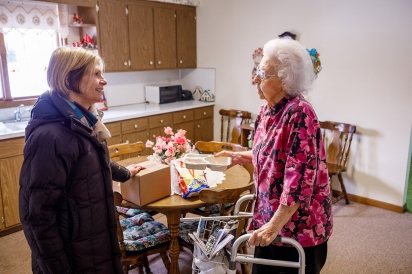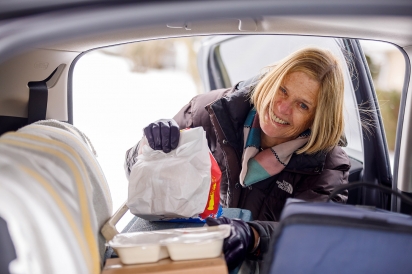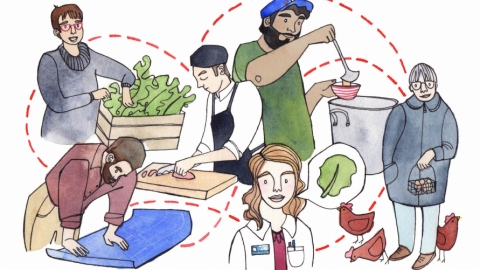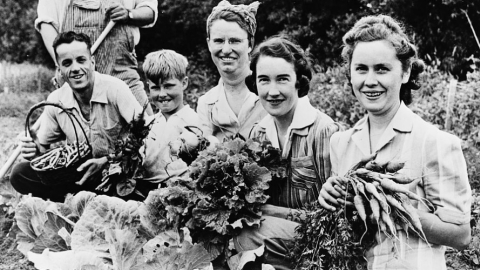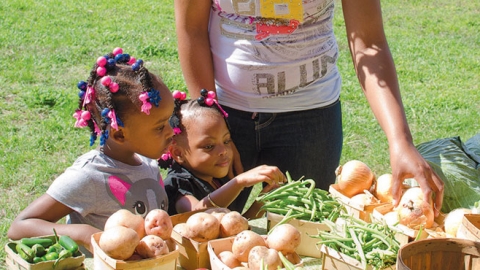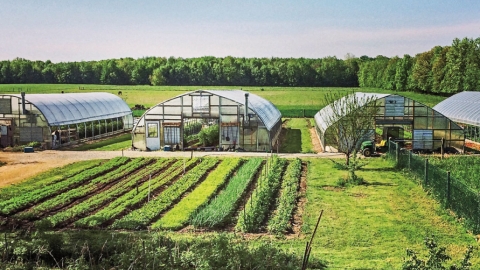Food rescue programs turn excess food into meals for those in need
On a recent trip to Trader Joe’s in my Michigan hometown, I encountered a bewildering sight: a nearly empty store.
The store wasn’t empty of customers— there were plenty of us ambling about in search of peanut butter pretzels— but the refrigerated shelves lining the perimeter were bare. No yogurt, no meat, no cheese, no pre-sliced fruits and vegetables.
A manager told me the store’s cooling system had failed briefly during the night, rendering the refrigerated products unsuitable for sale. I shuddered, envisioning dumpsters overflowing with healthy, delicious food.
As it turns out, I needn’t have harbored that ugly thought. Though it couldn’t be sold, the food was still within safety standards for donation, and 35,000 pounds of it—including ribeye steaks, artisan cheeses and salmon fillets— were already on semi-trucks en route to the local gospel mission, which packed its walk-in freezers with $60,000 worth of donated food.
Because the store acted quickly and had a transport system in place from previous donations, this “food rescue” provided hundreds of nutritious meals and prevented literal tons of waste.
Inspired by this act of corporate responsibility, I turned my attention to food rescue and recovery efforts closer to home. I learned that multiple Michiana programs are feeding the hungry by taking surplus food and putting it into the hands of those whose food budgets are stretched. Food rescue programs not only nourish bodies—they keep excess food out of landfills, protecting the planet, too.
What is food rescue?
Food rescue, also called food recovery or food salvage, is gathering food that would otherwise go to waste from restaurants, caterers, bakeries, farmers and grocers and distributing it to local food banks, food pantries, emergency food programs and other nonprofit organizations.
“Food waste is a natural by-product of running a business,” says Jim Conklin, president and co-founder of Cultivate Culinary School & Catering, a South Bend, IN, nonprofit organization that provides food rescue services and culinary arts training for people who face barriers to employment. “When you’re a caterer, you cannot run out of food. You always have to overestimate.” The larger the event, the greater the food waste—and that’s where food rescue programs like Cultivate come in.
Since the program began in July 2017, Cultivate has partnered with Notre Dame Athletics; Nelson’s Catering & Fundraising in Wakarusa, IN; Fresh Thyme Farmers Market and Rise’n Roll Bakery & Deli in Mishawaka, IN, rescuing nearly 40,000 pounds of excess food in 2017. With more than 42,000 individuals in St. Joseph County, IN—16% of the population—lacking reliable access to affordable, nutritious food, the need is apparent.
Cultivate re-donates food as is, or turns it into individual meals containing a protein, a starch and a vegetable. Meals are prepared in Cultivate’s kitchen by volunteers, packaged individually, sealed and frozen before they are delivered to subsidized housing units, soup kitchens and other nonprofits.
In the case of perishable food, it’s crucial to act quickly. After Notre Dame donated two 27-gallon tubs of fresh fruit following a home football game and its related events, Conklin and his staff immediately called local agencies, including St. Margaret’s House, a day shelter for women and children; Upper Room Recovery, an addiction recovery center; and Hope Rescue Mission to arrange a drop-off.
“The benefit for these organizations is that we can reduce their food costs,” Conklin says. “They can use those resources for their other programs.”
Keeping food safe
As with any organization handling food, food rescue programs must adhere to strict safety standards. Food that is donated is completely untouched—once it’s on the buffet line at a wedding or other event, it’s no longer safe to donate.
Food safety is a liability for anyone in the food business, but proper training ensures that donated food meets industry safety standards. Food must be labeled with preparation directions, allergens and an expiration date, for example.
“For years I had heard that we couldn’t donate our food, and it was heart-wrenching to see the waste,” says Bob Hollerbach, managing member of CK Catering in Benton Harbor, MI. But after learning that Detroit casinos donate their food, Hollerbach researched how he could safely adopt the practice. CK Catering now partners with Meals on Wheels of Southwestern Michigan for Gourmet Quick Bites, a program that provides senior citizens with individually packaged frozen meals such as grilled chicken breast with roasted root vegetables or pork with sweet potato mash. Meals are distributed through Berrien County senior centers, where seniors pick up the meals and consume them when they like, says Linda Strohl, executive director of Meals on Wheels of Southwestern Michigan. In a recent three-month period, about 130 people took advantage of Quick Bites.
“Our biggest challenge is having enough to meet the demand,” Strohl says. “Everyone has gotten very excited and is so happy to have the meals.”
Training the next generation
At Culver Academies, a fledgling food rescue program includes an educational “awareness-raising component,” says Chris Kline, the school’s sustainability director. Students are involved daily in taking excess food from their dining hall, which serves 2,500 meals per day, and portioning it into individual-sized containers with a single-serving entrée and two side dishes.
“Our students aren’t going hungry at night,” Kline says, “but many others in our community aren’t as fortunate. This program gives our students something to think about that they may not have considered before.” In addition, Kline addresses food waste in his environmental science class, explaining the role it plays in generating greenhouse gases.
To portion its turkey tetrazzini, baked ziti, lasagna and other leftover foods, Culver uses a small desktop press that seals food in a plastic container under a layer of polyethylene film. After learning about the machine used in a similar program at Tufts University in Boston, Lee Willhite, Culver’s dining service director, Kline and other dining services staff worked with the Marshall County Food Council to ensure the food met safety standards.
After the food is packaged, it is frozen and delivered in “glorified pizza delivery bags,” says Kline, to a local subsidized senior housing unit and a food pantry.
“The whole process involves a lot of people coming together—our students, dining staff, the food council and other local organizations,” Kline says. “It has taken a lot of coordinating to get it to happen, but we’re really proud of it.”
While Michiana food rescue programs have already played a significant role in reducing food waste and helping those who are hungry, those involved in food recovery say plenty of untapped resources are available to address food insecurity in our area.
“I’m convinced there’s so much food available, we’re barely touching it,” Conklin says. “We’ll keep on following our passion for eliminating waste and feeding hungry people at the same time.”
How to Reduce Your Food Waste
While corporate solutions to food waste make a big impact, small changes at home can add up, too. Follow these tips for making the most of your food at home:
- Meal plan. Before you reach for your cookbooks or make a shopping list, look at your calendar. Write down how many meals you expect to eat at home during the week so you only shop for what you’ll use.
- Google “produce storage cheat sheet” for helpful hints on how to care for each kind of produce. The average household throws away 22% of the fruits and vegetables it buys. Storing and caring for produce properly is key to reducing waste.
- Be mindful of leftovers and ingredients that are in danger of spoiling. We all know how easy it is to lose track of that half-eaten tub of yogurt. Designate a special area in your refrigerator for leftovers or foods that are soon to spoil. Mark them with a sticky note that says “Eat me first!” to remind yourself or family members.
- Limit kids’ pre-meal snacking, and make food easy to eat by cutting it into bite-size pieces, e.g., slicing your child’s banana rather than handing it to her whole. Those with young kids at home are likely to waste more food than other households, according to USDA research. With older kids, try the six-week food waste challenge at sustainableamerica.org—kids will have fun measuring wasted food and brainstorming ideas for how to waste less.
- Bring home (and eat) your leftovers when you eat out. Nearly 55% of restaurant food doesn’t get taken home, and 38% of leftovers taken home are never eaten.
Source for statistics: sustainableamerica.org




